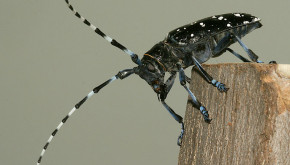
Invasive species are commanding a lot of natural resource professional’s time and attention these days. No matter where you live invasive species have the potential to impact your woodland acreages in a variety of ways and a landowner needs to be paying attention to what is going on in the woods and the surrounding landscape. Whether it concerns insects, diseases, plants, mammals or aquatic species there is something for everyone! One thing that is true across the board is that early detection is key to dealing more effectively with all of these. I am an Ohio woodland owner who has a section of my 80 acres of woods that contains 60% ash – I understand the importance of early detection!
In June of 2011 Ohio added another invasive insect pest to its already long list of issues – Asian longhorned beetle (ALB). As a group of us were discussing our new invader we kept coming back to the issue of how do we get these things reported early - when they are still on a relatively small scale. We were looking for new outreach tools to empower citizens to get involved – so that they could be our eyes across the state. One idea was the use of smart phone technology in the form of an app.
Page ahead to September 2012 and we are part of a group that launches the Great Lakes Early Detection Network (GLEDN). This smart phone app is a tool for citizens to identify and report suspect invasive species. The app can be used as an identification tool since it has multiple pictures available for each species listed in the app. There is an info tab that gives detailed information on key identification characteristics and why the species is an issue. The part of the app that makes it a great tool for early detection is it allows the user to take a photo (with gps coordinates) of the suspected invasive and uploads it to the EDDMapS system. The image is then sent on to an expert for verification (EDDMapS requires you to register with the system so you can be contacted for follow-up) and any follow-up measures that need to be made. Once the find is verified, a point is placed on a map, allowing all of us to address these issues more efficiently. Many times our thoughts of what are invasive or how wide-spread things are is based on anecdotal evidence. With this new tool we can get official sightings for many of our key issues and have a much better picture of what is out on the landscape.
Since we started work on this app Ohio has added hemlock wooly adelgid to our invasive insect known infestation list. We have also found walnut twig beetles – one part of the thousand canker disease complex. Early detection for all of these may make the difference between successful eradications or other management strategies and the total loss of key woodland species.
This free app is the creation of the University of Georgia’s Center for Invasive Species and Ecosystem Health. They will maintain the data that the app collects and update the app as we add things to the list. To access the mobile link for the app go to http://apps.bugwood.org/apps.html. Here you can access the GLEDN app and many others that they have created through their Bugwood network. Currently the app is available for Android – the iPhone version is in development.
One thing to keep in mind as you look at what is listed in the app as ‘invasive’ – this is a regional app. The intent is to make it a tool useful to those of us working on this issue across the Great Lakes Region. To that end there are species listed that may not appear to pose a problem in all areas of the Great Lakes Region. Help all of us utilize this new technology to combat our new forest pests!
Kathy Smith, Ohio State University Extension Forestry Program Director

